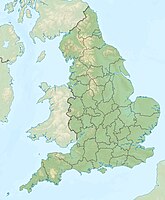Wisbech Castle
| Wisbech Castle | ||
|---|---|---|
 |
||
| Data | ||
| place | Wisbech | |
| Client | Wilhelm the conqueror | |
| Construction year | around 1068 | |
| Coordinates | 52 ° 38 '32.3 " N , 0 ° 9' 36.4" E | |
|
|
||
Wisbech Castle (also Castle Wisbech ) is a castle in Wisbech , Cambridgeshire .
history
Norman castle
The first building that was erected on the site of today's castle was a motte , which was probably built around 1068 at the instigation of Wilhelm the Conqueror . Initially made of wood, surrounded by a moat , it was built of stone until the death of William the Conqueror. While it is not mentioned in the Domesday Book , there are first written records of its use for the Diocese of Ely in 1215. Up to 1219 it was transferred to Richard Poore , Bishop of Salisbury , among others . In 1236 the castle was hit by a heavy flood , but it was still inhabited. At the end of the 13th century the building was used as a prison and court. Among other things, Robert Bruce's wife was imprisoned at Wisbech Castle.
The castle as a bishop's palace
Most of the buildings were demolished in 1478 and a new structure was erected in their place as a palace for John Morton , Archbishop of Salisbury at the time. His successor John Alcock expanded the palace and died there in 1500. While the palace passed into the possession of Mary Queen of Scots in 1553 , it was previously held by Robert Dudley under Jane Gray . Under Elizabeth I , the castle was used as a prison again for a short time before it was left to decay.
The castle as the residence of John Thurloe and return to church use
During the Commonwealth of England , Wisbech Castle, like many of the Church-owned estates, was confiscated. John Thurloe bought the property and had the remains of the bishop's palace removed to build a mansion . He probably commissioned the architect Peter Mills with the design. After the construction work was completed, Thurloe only lived in the house for a short time, because after the Stuart restoration , the building fell back to the church and was assigned to the diocese of Ely . Although it served as the bishop's accommodation on the bishop's rare visits, it was rented out most of the time. In 1793 the property was divided into several parts, which were then offered for sale. Joseph Medworth, a wealthy bricklayer, bought the property as a whole. After living in the mansion for over 20 years, he tore it down and built a villa in its place .
The Villa
Medworth's villa was built from materials that were left over from the demolition of the old manor house. The new building was built in the Victorian style . After Medworth's death in 1827, his heirs sold the property to a banker in 1864. He owned it until 1932 before giving it to the Borough of Wisbech . During this time, the villa served, among other things, as a school building. In 1957 the villa went back into private ownership, but in 1969 it was again taken over by the Isle of Ely and Cambridgeshire Education Authority .
Wisbech Castle today
Today Wisbech Castle is owned by Cambridgeshire County Council . This operates one of three training and further education centers there. It is also involved in the city's activities and offers, for example, a Christmas market . The premises can also be rented for exhibitions, conferences and weddings.
Excavations
In 2009 excavations were carried out on the grounds of Wisbech Castle with the support of the Heritage Lottery Fund . Supported by Cranfield University and Oxford Archeology , a company specializing in excavations, over 80 volunteers took part in the excavations. As a result of the work, a complete map of the vaults of the former bishop's palace could be created for the first time. The project was nominated for the British Archaeological Awards in 2010 and took second place.
